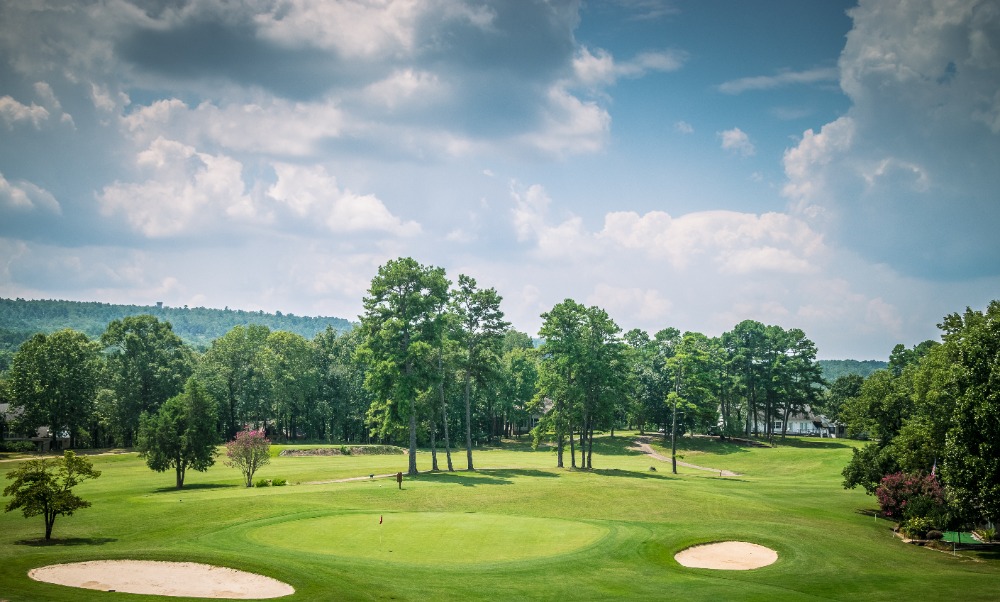|
Hole by Hole Description
Located on the outskirts of Lake Catherine State Park, Diamondhead Golf Club is a beautiful par-72 course with five different tee boxes allowing for an enjoyable experience for low to high handicappers, from players young to old, and from short knockers to the longest of drivers. There are many holes with doglegs, so take advantage of your length and creativity. It may sound simplistic, but it is of utmost importance to keep your approach shots below the flag. Though not the fastest, almost every green features sharp, twisting, downhill breaks.
The front nine is slightly shorter (3,008 yards from the white tee boxes) than the back (3,166 yards) but requires straighter shots because of its overall tightness. Golfers can benefit from a local rule on holes 5, 6, 7 and 8 that allow for free drops on shots which land in the ditches.
The back nine is more wide open, but creativity should be a golfer’s 15th club in their bag. Don’t think you are out of the woods once you get done with the wide-open 15th and 16th holes. A very good round can turn sour quickly with poorly placed shots over the final two holes.
| No. 1 |
Par 4 |
17 Men's Handicap, 17 Women's Handicap |
| 336 yards |
|
320 yards |
|
294 yards |
|
282 yards |
|
182 yards |
|
A beautiful starting hole from way up high, this downhill tee shot allows golfers some extra yards right off the bat. Keep it straight all the way through the green by staying out of the trees on the left. A lateral hazard right runs from the bottom of the hill all the way through to the green. The smallest green on the course awaits, but a sidewinding putt is better than a downhiller.
KEY TO PAR: Take advantage of yards off the drive and get your second shot up a slight incline in front of the green to settle on or around the putting surface, but watch you don’t hit your second or third shot too far over the green. It’s a long way back up. |
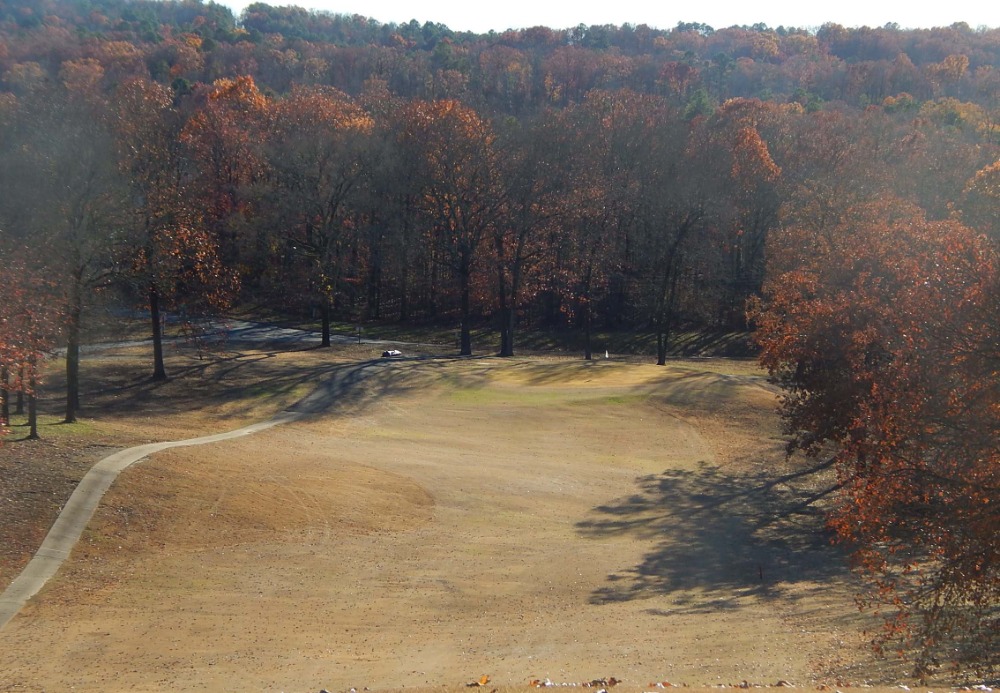
|
| No. 2 |
Par 3 |
13 Men’s handicap, 5 Women’s handicap |
| 178 yards |
|
149 yards |
|
144 yards |
|
130 yards |
|
120 yards |
|
Water surrounds a very wide green as golfers step to the tee. The pond in front is the biggest obstacle, so proper elevation is the key. Water also comes into play if there is a bad bounce left, a mishit right or too much club sends the ball over the green. Be cognizant of the pin placement and watch for the twists and turns of your putt. Take a two-putt and move to No. 3.
KEY TO PAR: Be sure your tee shot is high enough and also left enough of the big tree leaning over the front of the pond on the right. The green is long and wide, so a good chip is invaluable to get up and down for your 3. |
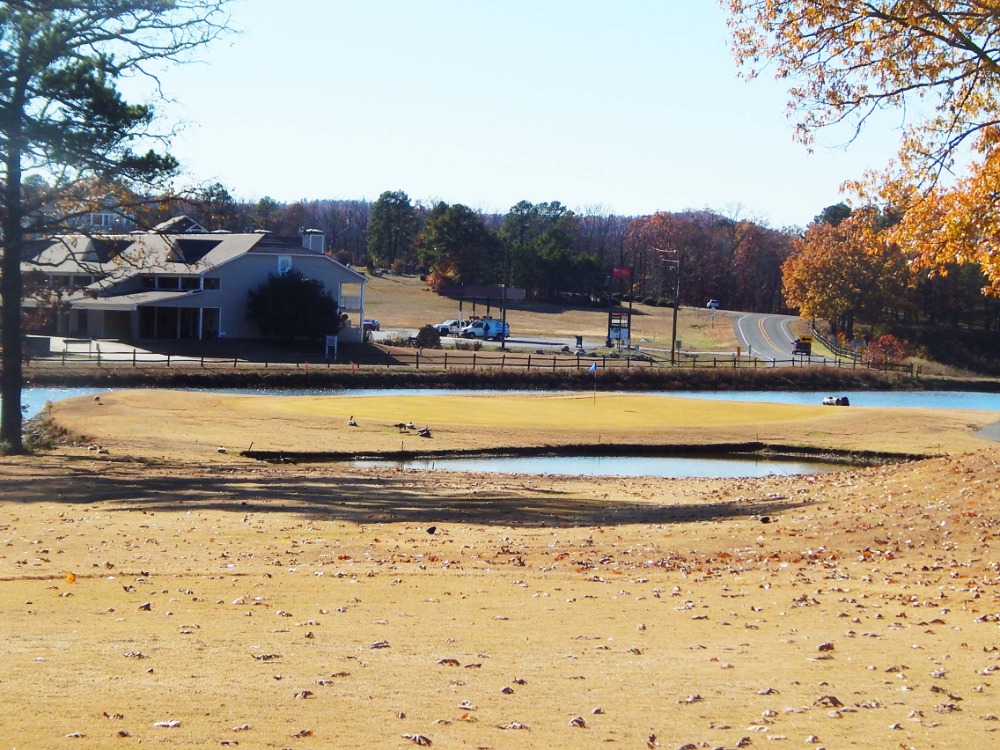 |
| No. 3 |
Par 4 |
9 Men’s handicap, 11 Women’s handicap |
| 335 yards |
|
315 yards |
|
287 yards |
|
273 yards |
|
200 yards |
|
The first of four consecutive holes featuring doglegs. Club selection off the tee is of utmost importance. Take enough to get over the huge pond in front, but it’s very easy to hit it too far through the right side which is OB. A wayward tee shot left puts you into trees where you are left with a punch shot back into the fairway unless you are brave enough to thread the needle to the green.
KEY TO PAR: Par is tough if the tee shot isn’t in the middle or right side of the fairway. Make sure you have enough club on your second shot to reach the uphill green which has hidden bunkers to the right and behind it.
|
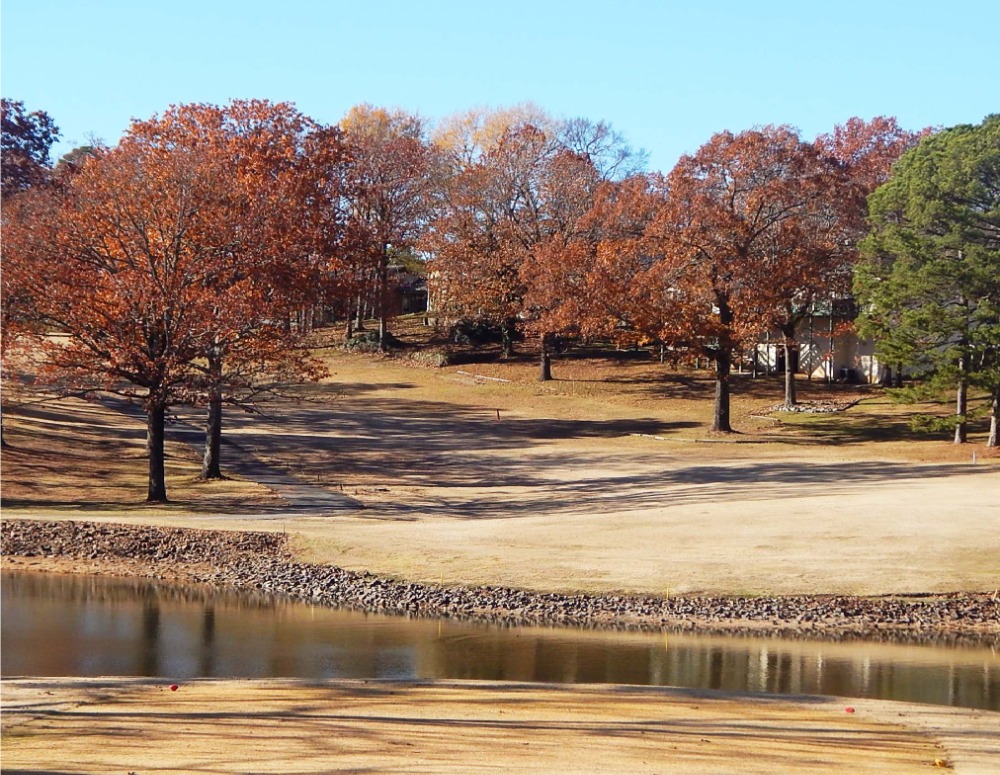 |
| No. 4 |
Par 4 |
5 Men’s handicap, 13 Women’s handicap |
| 416 yards |
|
383 yards |
|
332 yards |
|
320 yards |
|
197 yards |
|
The club’s signature hole, No. 4 features a picturesque tee shot from the blue and white tee boxes. A left-to-right tee shot is perfect but don’t get overconfident and overcompensate. Trees surround the cart path when it goes back to the right. From there, one bad kick off a tree can land in the lateral hazard right or go too far through the trees and head out of bounds. A tee shot that leaks left can also land out of bounds, but a fortuitous bounce can put the ball back in play. A slightly uphill and forgiving green is ripe for a birdie with a great second shot.
KEY TO PAR: Keep the ball in the left-center of the fairway off the tee and rip either a high or low second shot but keep it straight. Losing it left or right can lead to a bad bounce and a sure bogey. Probably the truest green of any on the course.
|
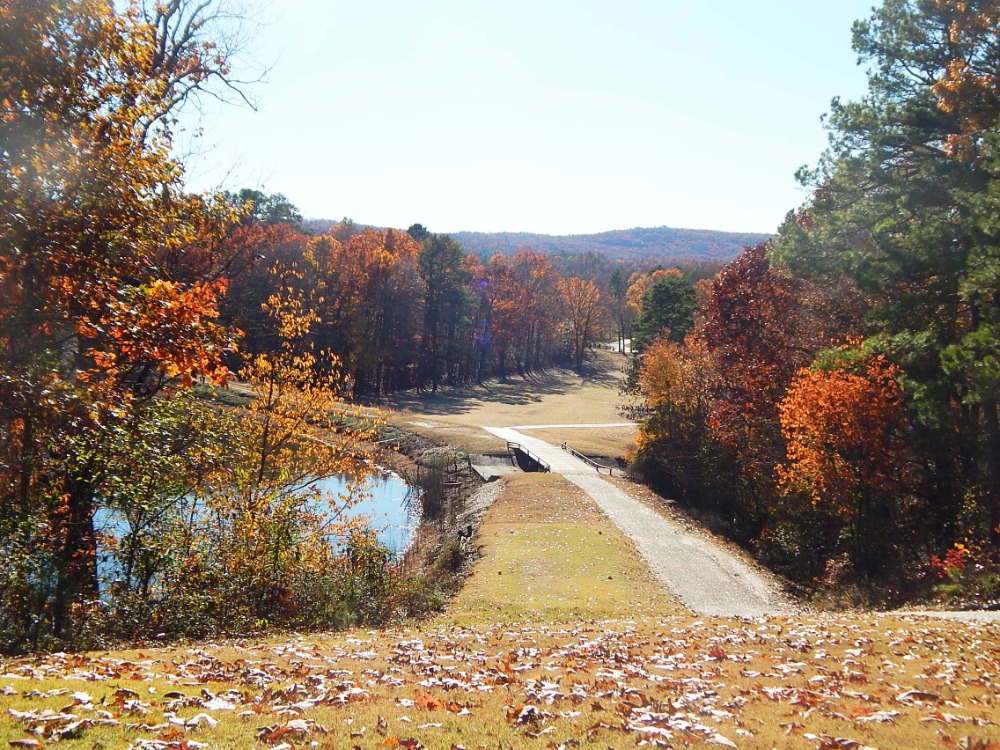 |
| No. 5 |
Par 4 |
11 Men’s handicap, 9 Women’s handicap |
| 360 yards |
|
343 yards |
|
337 yards |
|
329 yards |
|
287 yards |
|
The ditch left is your best friend if your tee shot strays especially if it hits the larger of the trees about 150 yards from the green. A tee shot right is the shorter path, but overhanging tree limbs can lead to a difficult approach. Bring plenty of firepower to get to the front edge of the green, as the ground can be soft just off of it. The green is one of the longest on the front side, so just get it there, but lose your approach left and it will rattle off the restroom. Lose it right and listen to it hit off the cart path a couple of times then watch it roll to the creek down below.
KEY TO PAR: Not too long but not too short, this hole takes a good putter to make par. No matter where the flag is, make sure you read your putt from a couple of angles. Don’t be surprised if there are a couple of breaks on 10-foot-plus putts, so trust your instincts.
|
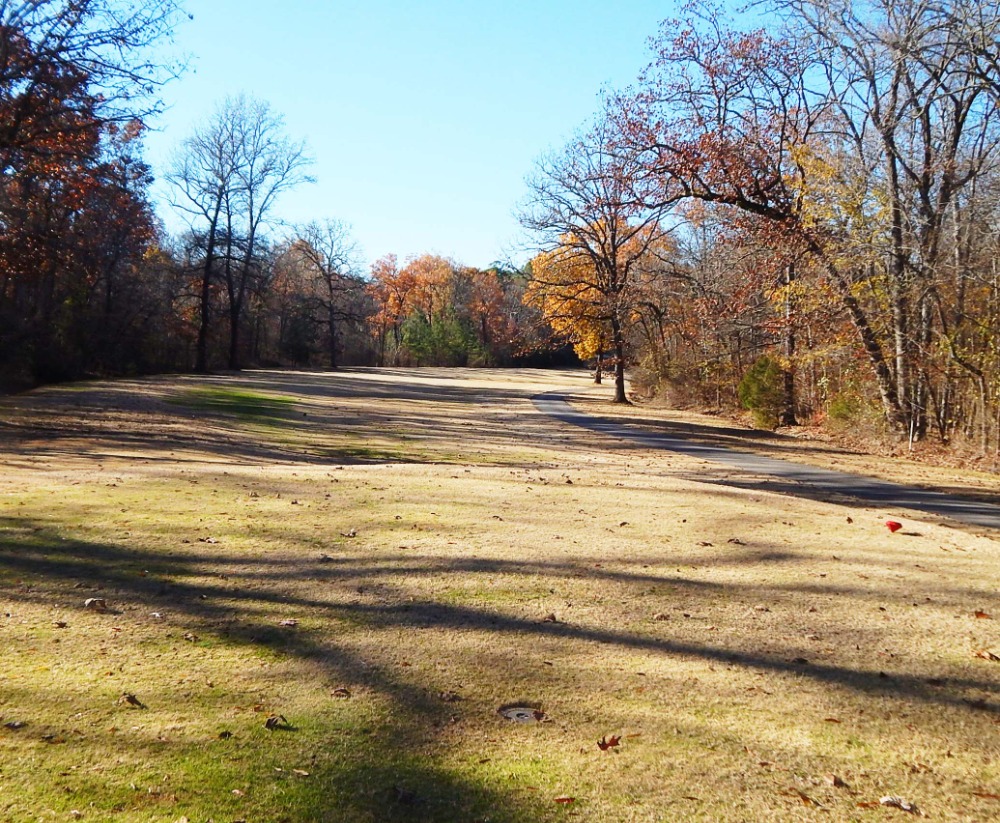 |
| No. 6 |
Par 5 |
1 Men’s handicap, 1 Women’s handicap |
| 518 yards |
|
500 yards |
|
447 yards |
|
431 yards |
|
337 yards |
|
With a unique dogleg, ball placement is the key to playing this par 5. A small percentage of long hitters can take the ball over the trees on the right and find the center of the fairway with hopes of reaching the green in two and making eagle. Shorter hitters can take the ball up either side of the fairway to leave a short to mid-iron into the green with their third shot. Keeping the ball below the hole with your approach shot is paramount, but don’t be too timid or you will be faced with a tough chip on to the green from the left, right or front. Go too far past the hole and you could be facing an eventual three-putt for bogey or worse.
KEY TO PAR: Starting with two solid shots will give you some confidence. Remember, the ditches are your friend with no penalty if you can locate your ball. It’s OK to be short and in the middle with your third short, but a nice chip and putt can help you make an easy 5.
|
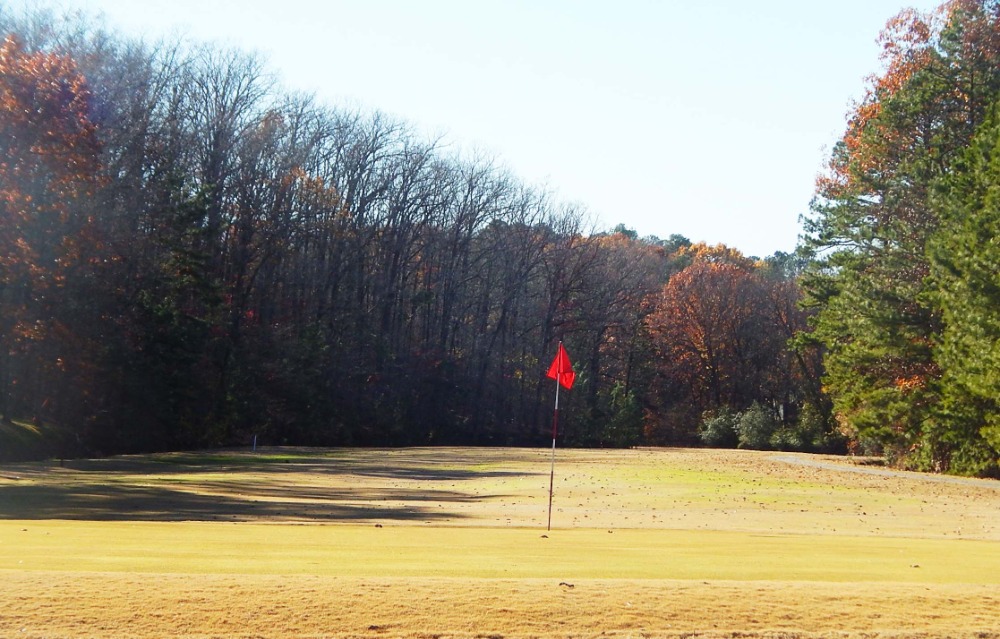 |
| No. 7 |
Par 3 |
15 Men’s handicap, 15 Women’s handicap |
| 165 yards |
|
155 yards |
|
151 yards |
|
147 yards |
|
130 yards |
|
A sand trap left and another right help protect the front sides of this par 3. Low-ball hitters can split the difference between the two bunkers and run the ball up a slight slope on to the green. Players should be careful trying to attack a pin on the left side. A wayward tee shot can bound off the cart path into the woods and out of bounds. Too far right can ricochet off the lone tree in play and bound over the ditch and out of bounds. A fortunate bounce could leave the ball in the ditch for a free drop. Again, it’s best to be putting up hill. A downhill sidewinder can lead to disaster.
KEY TO PAR: No matter where the flag is, aiming for the center of this huge green probably yields the greatest results for the average player. Being short and straight keeps the bunkers out of play and keeps getting up and down in play. Give an uphill putt a little extra force.
|
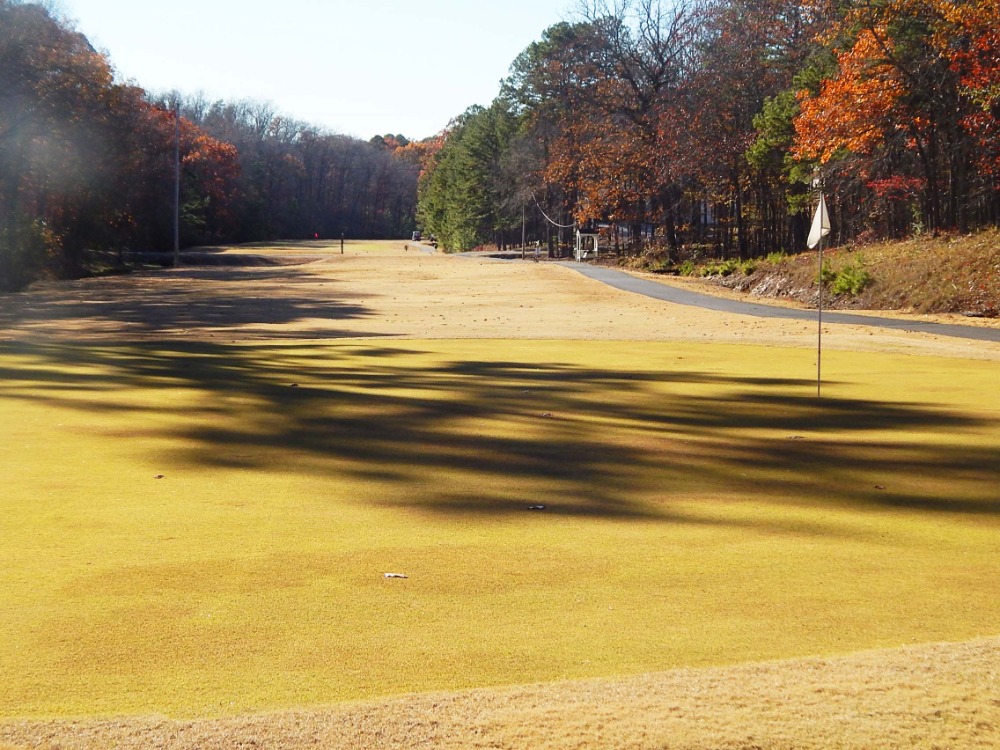 |
| No. 8 |
Par 4 |
7 Men’s handicap, 7 Women’s handicap |
| 338 yards |
|
326 yards |
|
290 yards |
|
277 yards |
|
148 yards |
|
If there were ever a time to hit two precise back-to-back shots, it’s on this 90-degree dogleg left. Care must be taken for any tee shot hit just left toward the bottom of a huge hill. It could ultimately kick toward the green tee box or even to the ditch beyond the fairway. Anything straight still must get just beyond the center of the fairway to take a tall pine tree out of play on the straight uphill approach shot. Just look for the tall flag and get it to the huge green, but be careful – slightly left of the green is better than slightly right where the cart path runs toward the road OB. Go too long and suffer the consequences.
KEY TO PAR: Try to hit your tee shot as close to the bottom of the hill as possible and hope you are not blocked by a large pine tree. If you stay close to that spot, look for the flag through a gap between the two pines. Wherever your tee shot stops, if you can get your yardage, be sure to take at least one or even two extra clubs and go flag hunting. If you don’t allow for extra yards, remember you are going straight uphill and you can ultimately hit your next shot from the same spot you just hit from or maybe even further when it rolls past you.
|
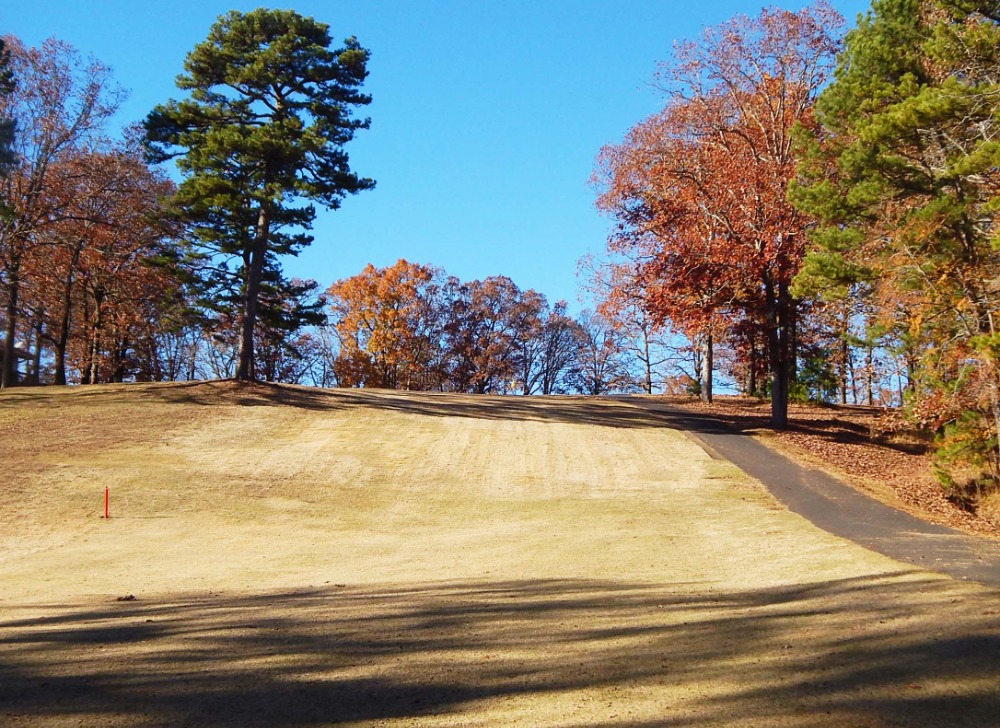 |
| No. 9 |
Par 5 |
3 Men’s handicap, 3 Women’s handicap |
| 548 yards |
|
517 yards |
|
496 yards |
|
483 yards |
|
377 yards |
|
With a tee shot uphill but a safe distance away, it is imperative to keep your drive in the fairway. Keep your ball to the left side of the fairway until you get to the top of the hill about 200 yards from the hole. Anything left of the fairway are trees all the way to the green and anything right keeps you in jail until you get past the trees at the top of the hill on the left side of the cart path. Just down from the 200-yard marker, be ready for a downhill slope leading to the large green.
KEY TO PAR: Keep your tee shot along the left side and watch it funnel toward the center of the fairway, but don’t get too close to the tree line. Thread the needle on your second shot to leave your next shot staring at the flag. Don’t overcompensate and get too cute if you have a downhill lie. A bad kick off the slope on the left side of the green or a ball off the cart path right just feet off the green can turn par into double bogey very quickly.
|
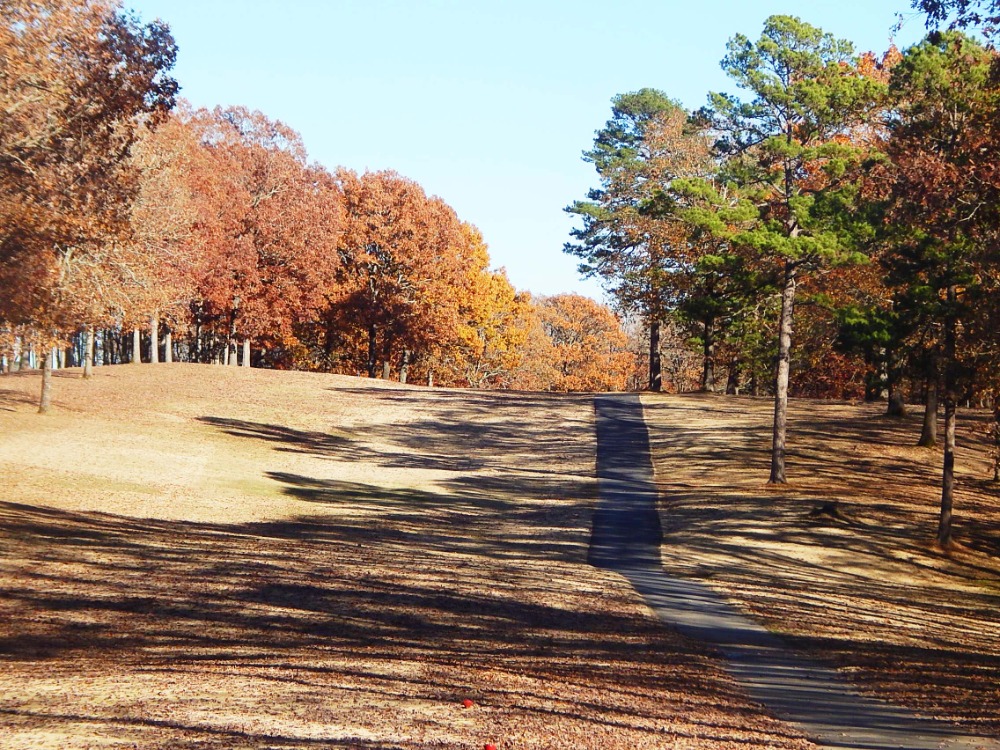 |
FRONT 9 PAR - 36 TOTALS
| |
3194 yards |
|
3008 yards |
|
2778 yards |
|
2672 yards |
|
1978 yards |
| No. 10 |
Par 4 |
16 Men’s handicap, 16 Women’s handicap |
| 392 yards |
|
366 yards |
|
363 yards |
|
351 yards |
|
221 yards |
|
If you thought No. 8 was an amusement park ride, you’ll think No. 10 with its dogleg right is a roller coaster. High-handicap players tend to play their tee shot down the middle of the fairway hoping it slowly leaks right while trying to avoid trees along its route to the edge of the dogleg to gain needed extra yards and get to within 150-170 yards of the green. Low handicappers try to take their ball high over the trees looking for that same right-hand turn which will put their ball within 100 yards if properly executed. A mishit could easily result in a collision with a tree and a lost ball or one out of bounds. If your ball goes too far long and right, be cognizant of the small closed-off burial plot at the top of the hill. Anything in the center of this plush fairway gives the golfer a perfect downhill look at a large green.
KEY TO PAR: The fairway is definitely your friend. Even mishit shots into it can get to the green, especially if you hit a worm burner down the hill in front of it. Hope there is a white or a blue flag that day and you are left with a little uphill, sideways putt attempt because any approach shot hit behind it will lead to a putt running several feet off the green if you miss that little knee-knocking 3-footer.
|
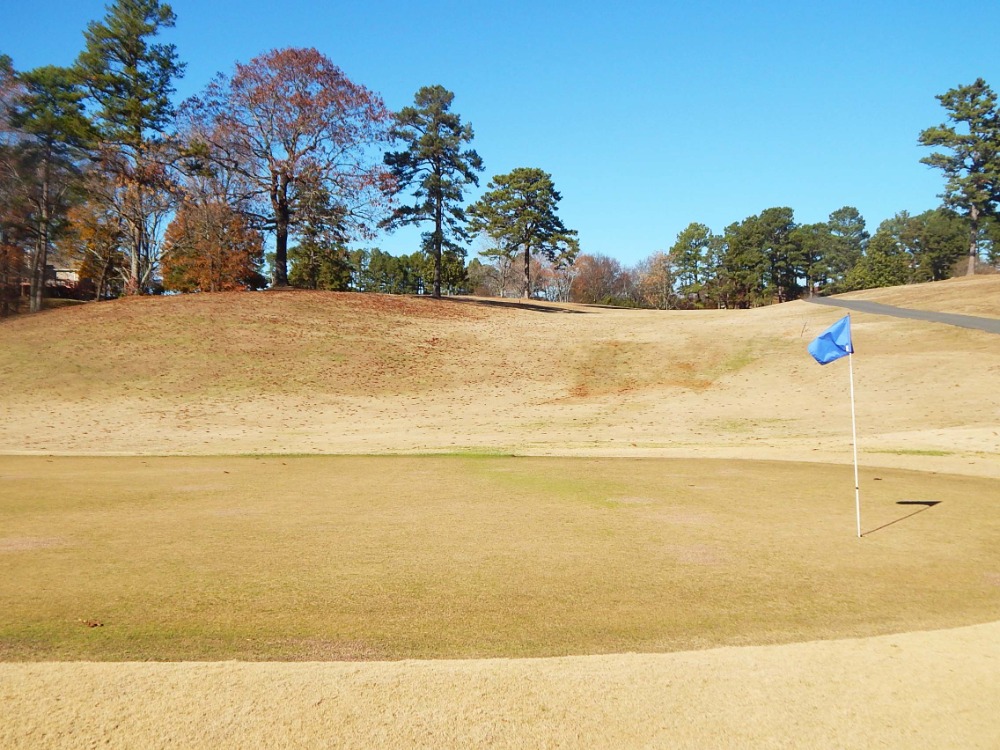 |
| No. 11 |
Par 3 |
18 Men’s handicap, 18 Women’s handicap |
| 158 yards |
|
133 yards |
|
125 yards |
|
109 yards |
|
91 yards |
|
Take an immediate left off the tee and your ball is knocking on wood. Go long and left and you are in deep rough or staring at a tough bunker shot for your second. Short right leaves a tough up and down, while long and right could take a crazy hop off the slope and land out of bounds. Bottom line: Keep it straight to the hole. Sounds simple, right?
KEY TO PAR: Yes, it is the shortest hole on the course and yields its share of aces, but with all of the twists and turns on the green, you could easily become the next resident of Three-Putt City. Miss the green short then watch the bounce and break of your chip shot on your second shot before draining that hard-earned par.
|
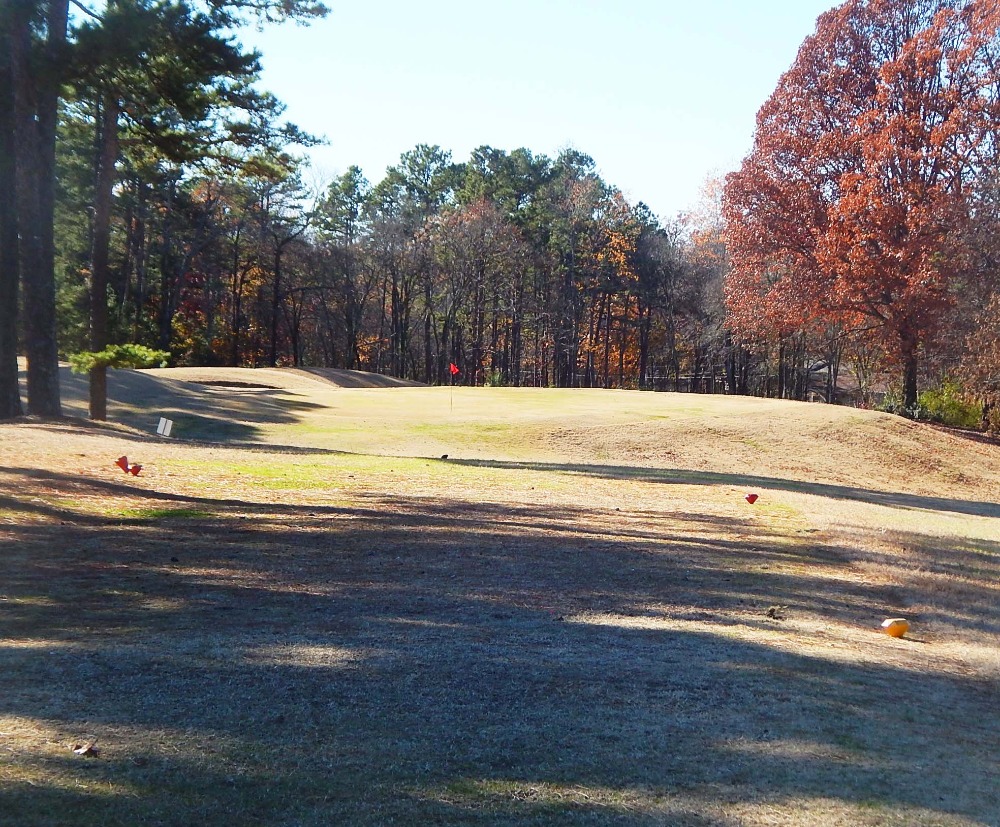 |
| No. 12 |
Par 4 |
12 Men’s handicap, 6 Women’s handicap |
| 383 yards |
|
341 yards |
|
328 yards |
|
241 yards |
|
207 yards |
|
A huge pond sits just under 100 yards from the green, so choose your weapon of choice wisely off the tee particularly on a dry, windy day where your ball could end up becoming fish or turtle food. Too far left off the tee can land in deep rough and laying up might be an option. You can’t see how the cart path winds, but keep your tee shot left of it because anything right is sure to end up out of bounds further down the cart path. Sand traps can be found left and right beside the green.
KEY TO PAR: A straight solid shot off the tee can lead to a good roll downhill into a flat lie. Anything 100-150 yards out from this plush fairway will allow you to go pin hunting, but be sure to take enough club to get over the pond. A nice chip from in front of the green can lead to an easy up-and-down.
|
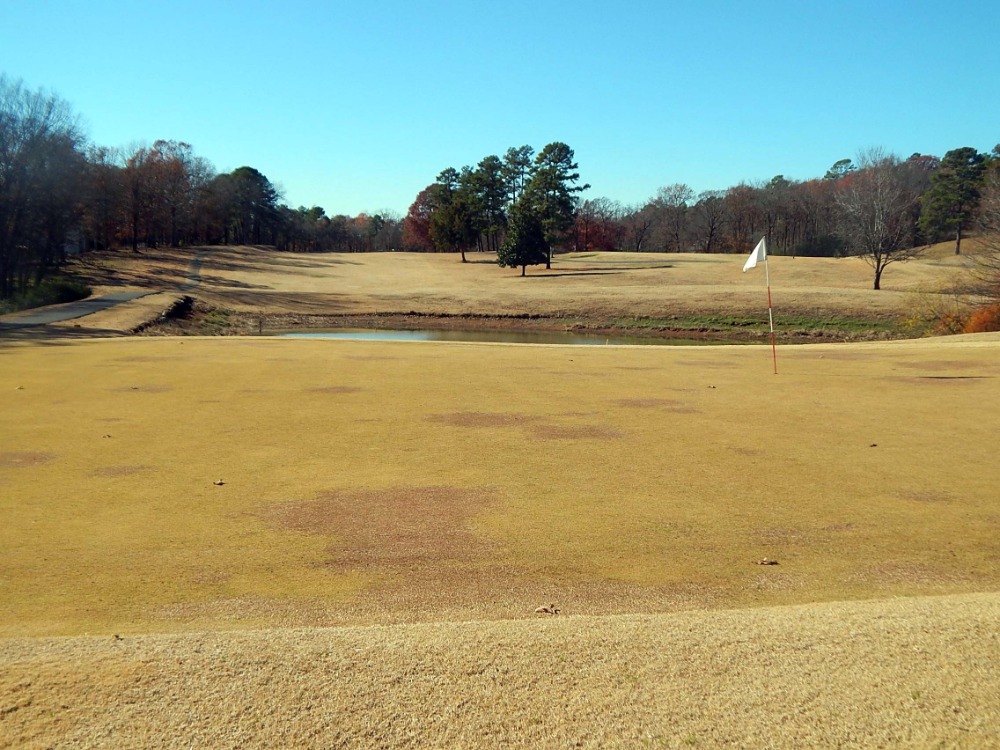 |
| No. 13 |
Par 5 |
14 Men’s handicap, 14 Women’s handicap |
| 482 yards |
|
470 yards |
|
418 yards |
|
398 yards |
|
325 yards |
|
If you’re thinking of making an eagle on a Diamondhead par 5, this is your best (and more-than-likely last) chance. The hole offers a blind tee shot, so pick out a target – preferably few yards right of the pine trees seen left in the distance which are just off the cart path – then let it rip. Unless your ball moves left, try not to use the hump to the right as a guide. A shot right of it can lead to a lost ball or one too far can go out of bounds. Once you have a clear view of the green, keep pushing your ball to the hole and benefit from the fairway sloping toward the cart path for extra yards, but watch out for a small tree, then a bunker left in front of the green. Take it too far down the cart path left and your ball can land in a lateral hazard or even worse it can keep going down the street and out of bounds.
KEY TO PAR: Putting your tee shot in the fairway anywhere past the green tee box is a good start so you can now see the green. Wail away on your second into a wide-open fairway keeping it right of the sand trap just left of the green. Maybe you can run it onto the green or leave it just short where an up-and-down chip and putt salvages an easy par (but wouldn’t birdie be better?)
|
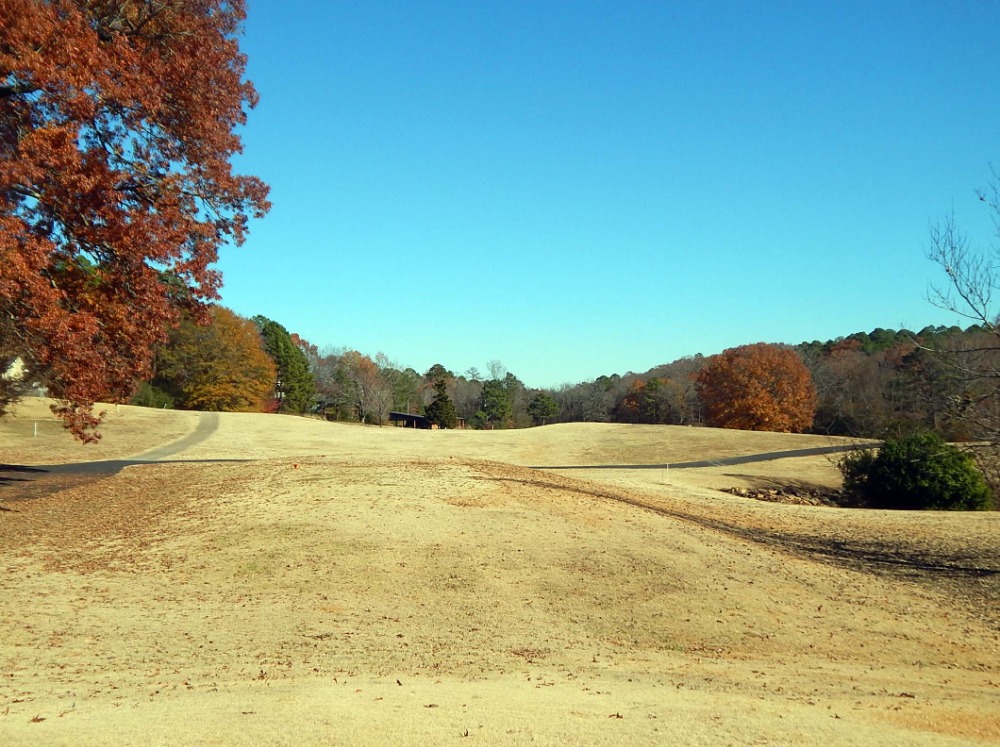 |
| No. 14 |
Par 3 |
6 Men’s handicap, 8 Women’s handicap |
| 196 yards |
|
169 yards |
|
160 yards |
|
148 yards |
|
74 yards |
|
The mother of all par 3s. If it wasn’t bad enough having to hit a shot to a blind target where you can just barely see the flag, try shaking your nerves long enough to get the ball into the hole on this large and severely sloping green. Some locals like to tee a driver low and run it up the hill on to the green with varied success. A well-struck drive left of the green has the likelihood of hitting the cart path or it can even take a wicked bounce off the slope and out of bounds, so a miss right isn’t all that bad except for the thick rough you’ll be hitting from. That should leave plenty of room to leave your ball below the hole on your chip. Quickly take your two-putt and move on to No. 15.
KEY TO PAR: There really is a flag on top of the hill. Hit a good tee shot and hope for the best. Then again, maybe you and your buddies would like to try your luck from the much-closer green tee box?
|
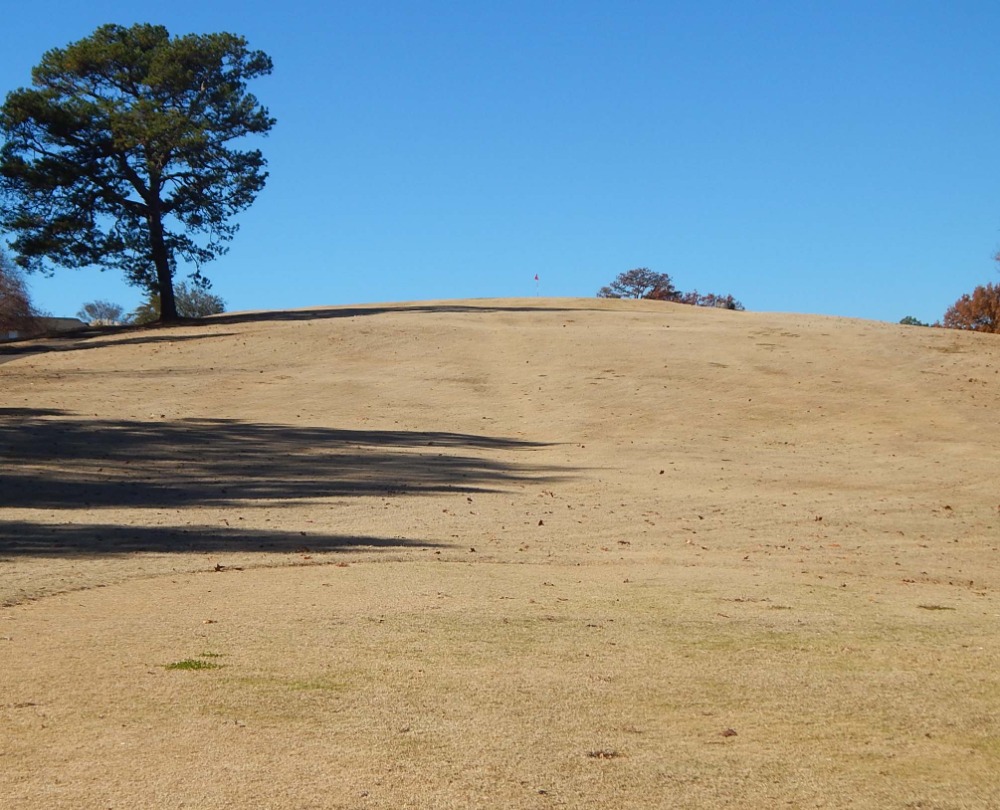 |
| No. 15 |
Par 4 |
8 Men’s handicap, 4 Women’s handicap |
| 395 yards |
|
361 yards |
|
333 yards |
|
320 yards |
|
248 yards |
|
After recovering from No. 14, this par 4 is a sigh of relief to many. But don’t think trouble doesn’t exist. First things first is navigating your drive over (or around if you prefer) a ball-eating Magnolia tree straight ahead just off the tee box. Too far down the left side of the fairway can leave you with a blocked second shot or worse, see your tee shot head out of bounds. Left of the cart path is good, but right can get you in trouble with trees and deep rough. Keep pushing forward and split the bunkers protecting the front of the green, but make sure you have enough carry if you go flag hunting. The green is very receptive to properly struck shots on to the putting surface.
KEY TO PAR: Right center of the fairway is the place to be as you start thinking about making a 4. If you are going to miss on your second shot, miss right to avoid the sand traps and into the rough on top of the hill. Don’t be too short if you do go right. Golfers are surprised when they can’t find their ball because it has gravitated into the pond. Trust your stroke when you are on the green. Daily players and members insist every putt is a straight one from all angles. Are they right?
|
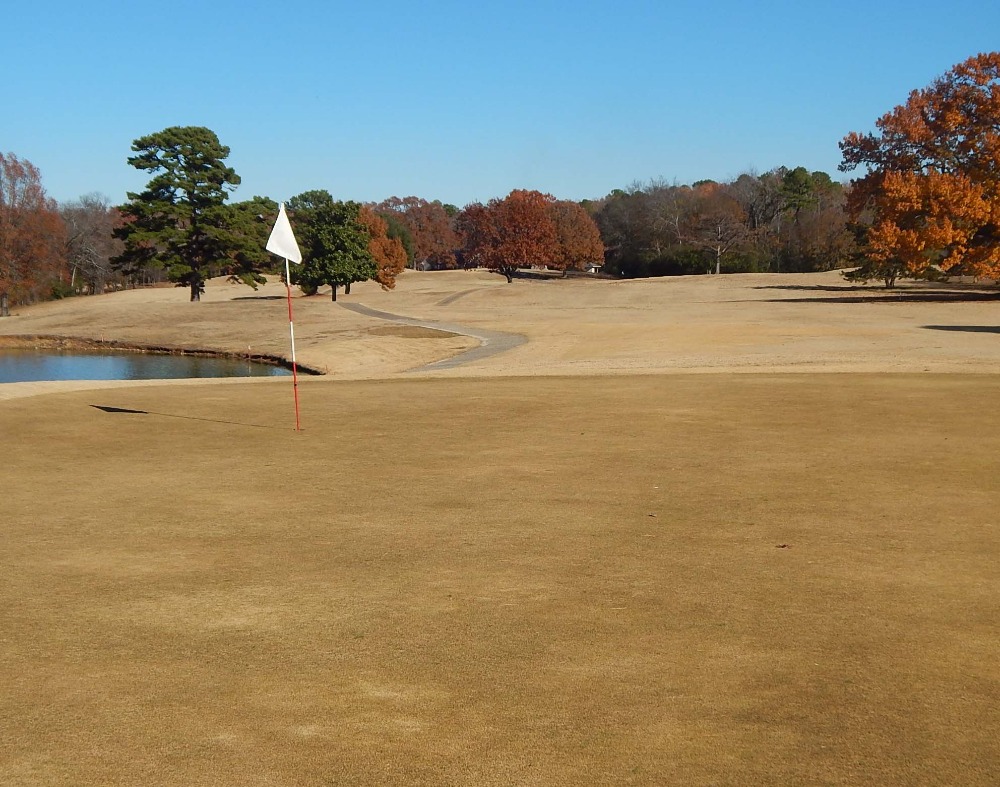 |
| No. 16 |
Par 4 |
6 Men’s handicap, 10 Women’s handicap |
| 423 yards |
|
392 yards |
|
329 yards |
|
321 yards |
|
247 yards |
|
The longest par 4 on the course, this isn’t the hole you want to be playing with a stiff breeze in your face or even have a sideways gust which can take your ball left for an unfavorable bounce out of bounds or behind a huge tree right where low-hanging trees can leave you chopping your ball just a few yards at a time. Get the ball into the fairway, aim straight ahead and miss the sand on the right. Missing the green long can leave you making a blind pitch back up the hill.
KEY TO PAR: Tee it high and let it fly, right? Anything 125-150 yards from the center of the fairway should leave you salivating for your second shot. If you’re second-guessing your club selection, be sure and go with the longer club unless you want to see your second shot come up 10 to 20 yards short. Higher-handicap players have difficulties reading this green, so study it wisely.
|
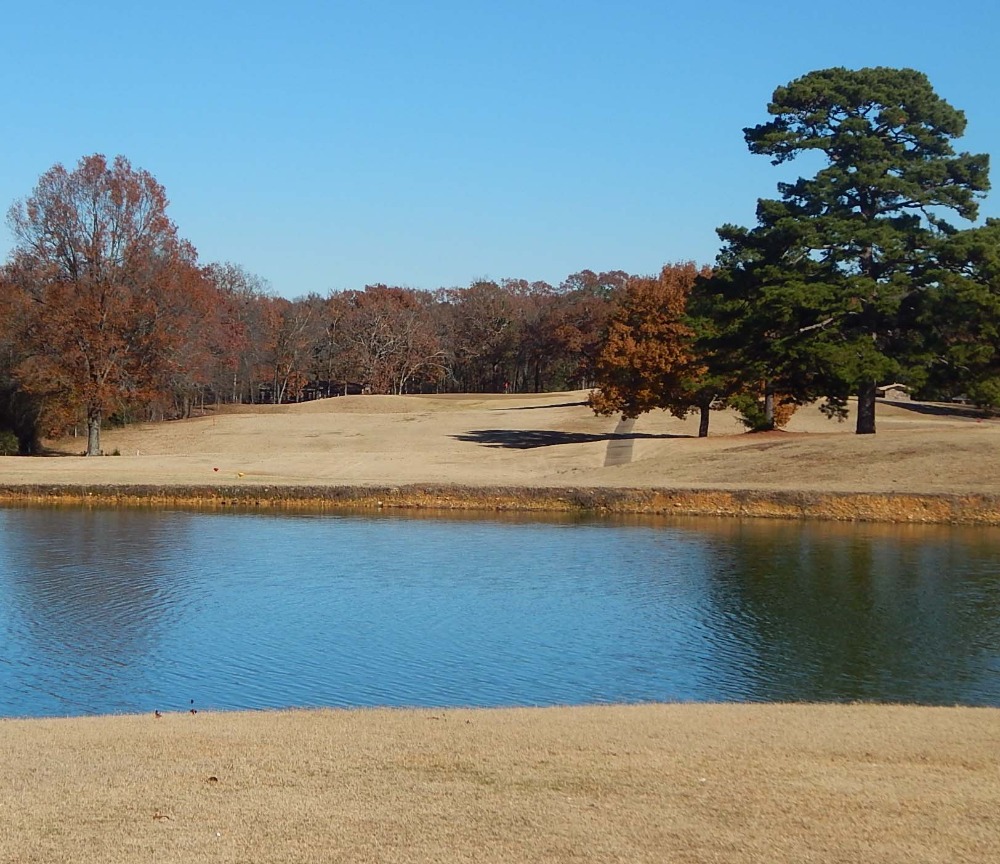 |
| No. 17 |
Par 4 |
10 Men’s handicap, 12 Women’s handicap |
| 418 yards |
|
383 yards |
|
372 yards |
|
326 yards |
|
215 yards |
|
Pretty much the twin of No. 10 but in reverse. First-timers may want to take the safe route and play their tee shot down the center of the fairway. Players may get brave and try to go over the trees to land in a fairway about 60-70 yards wide to leave them 120-150 out. Shots hit right going into the green have a better chance finding the putting surface, but watch the huge tree just feet from the cart path. Too far right can go down a slope. Short left is sand, while too far left or behind the green can lead to a treacherous uphill pitch. No matter the angle you are putting from, remember no two putts are rarely the same on this hole.
KEY TO PAR: The hole sets up well for a left-hander who can hit a 3 or 5 wood with a high fade or a right-hander with a high draw. If this is your plan of attack, make sure your playing partners are quiet after you hit so they can listen for the ball to hit a tree or two. Your ball can be anywhere after that. Find it safe and you are perfectly lined up for a second shot into a huge green with its share of slopes. A two-putt never felt so good.
|
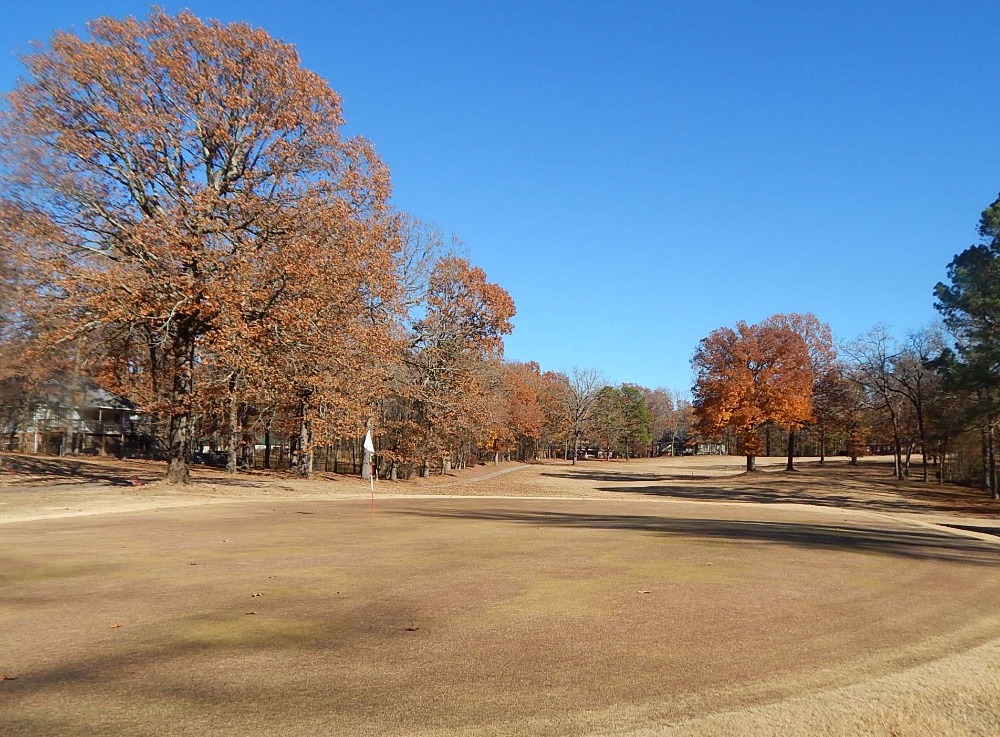 |
| No. 18 |
Par 5 |
2 Men’s handicap, 2 Women’s handicap |
| 580 yards |
|
551 yards |
|
477 yards |
|
464 yards |
|
369 yards |
|
Remember the par-5 13th as the best chance to make eagle? Well, bring your lunch on No. 18, which is well-deserving of the No. 2 handicap hole. This is the only hole where golfers playing from the green tee box must navigate a dog leg. Wherever you play from, the tee shot needs to be in the middle or right side of the fairway. From there, it is open in the center just beyond where the cart path cuts across, but you haven’t gotten it past the dogleg and probably need another 20-30 yards to have a clearer view at the hole. The hole sits on top of a hill so make sure you have plenty of club. Going left isn’t the end of the world, but hope to be short if you go right because out of bounds sits immediately right of the cart path. Another huge green with a severe slope awaits your finish.
KEY TO PAR: Forget par if you are too far left off the tee. Hitting left to right is ideal, but if you do play right to left try going over the trees. The second shot is probably the most important. Locate the 150-yard marker on the left side of the fairway. A good poke at the stake should yield great results. Too far left of it and you are in the woods or OB. Hit one hot past the marker and look in the woods right for your third shot. If you are fortunate to be 130-160 yards out for your third shot, take a little extra at the green. From there, again, hope you are putting or chipping up hill. Though it would be outstanding, don’t leave your birdie attempt short. By the same token, too much aggression — particularly with a flag on one of the front edges — will leave you wishing your putt would finally stop.
|
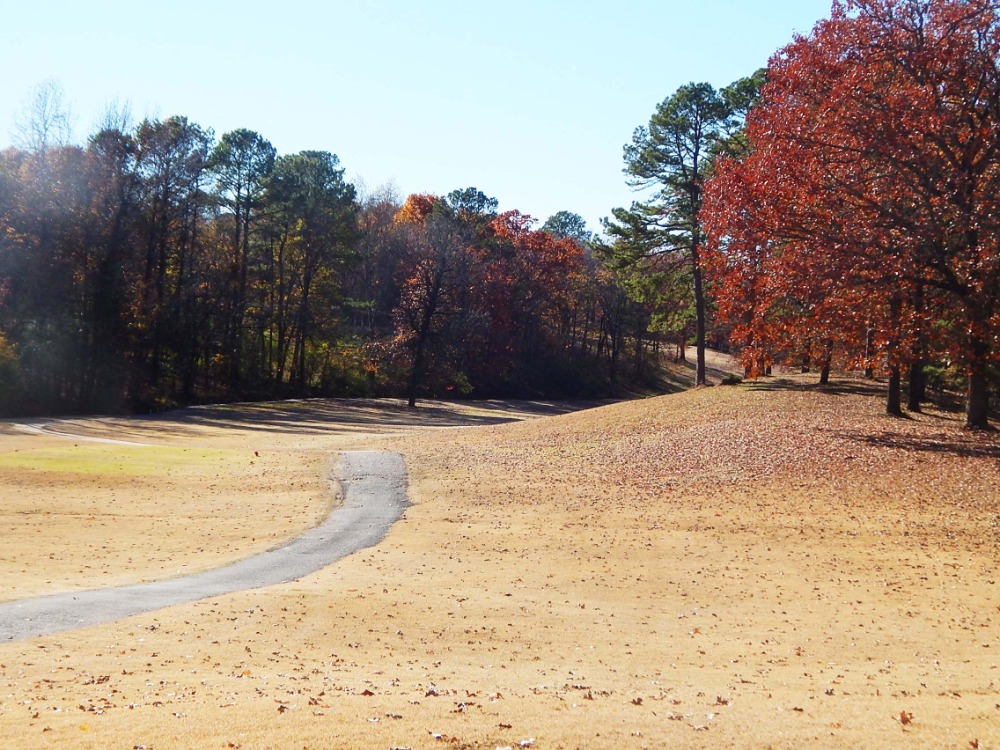
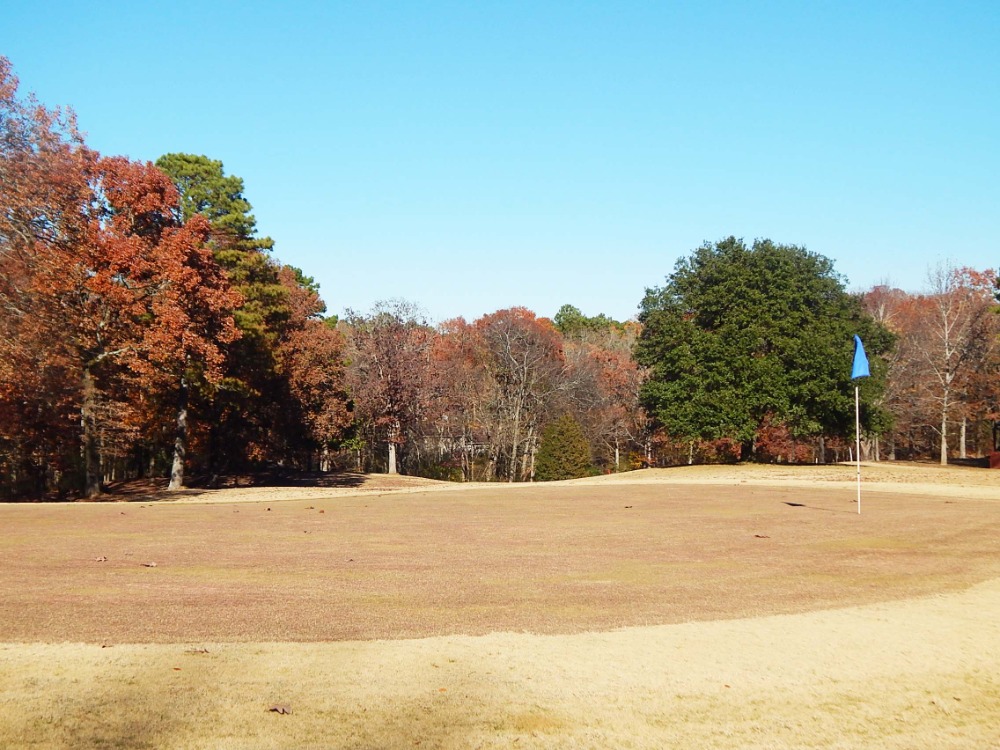 |
BACK NINE PAR - 36 TOTALS
| |
3427 yards |
|
3166 yards |
|
2905 yards |
|
2678 yards |
|
1997 yards |
| |
6621 yards |
|
6174 yards |
|
5683 yards |
|
5350 yards |
|
3975 yards |
|

